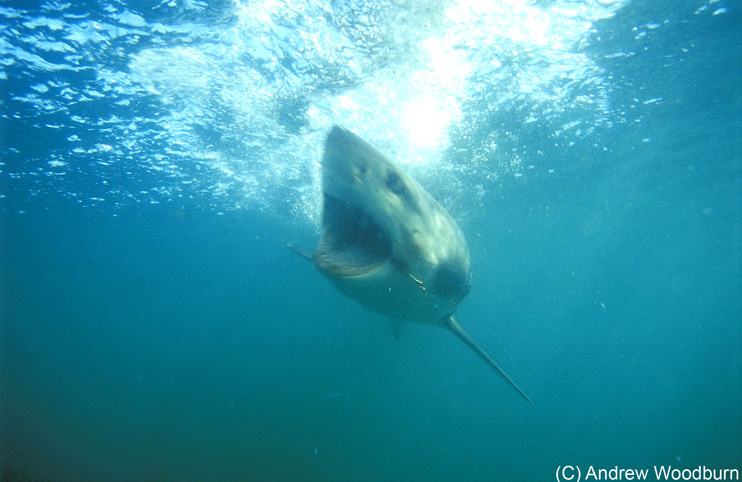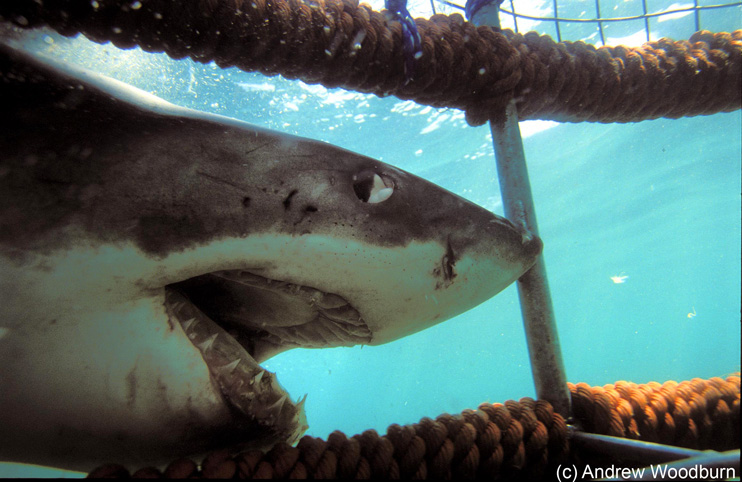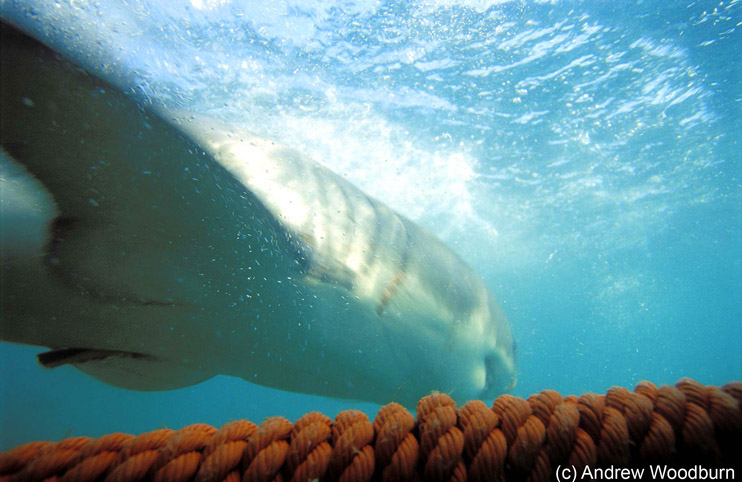South Africa, Gansbaai's shark alley at Dyer island is one of the globes best sites for Great White Shark cage diving and shark photography and watching. Great White Sharks arrive here from all over the Indian Ocean in order to predate on seals which haul out onto the rocky islands to pup and rest. This opportunity allows unique interactions with great white sharks underwater using shark cage diving from eco tourism to scientific research.
Andrew Woodburn has visited this Great White Shark mecca on a few occasions and it was one of these visits that the following occurred.
 |
I was doing breath hold in the shark cage in order to minimize the noise of scuba diving bubbles and had submerged to photograph a juvenile great white shark that had followed the bait as it passed by the shark cage. This particular white shark had been the most active around the shark diving cage on this day. It used speed and uncharacteristic random appearances, darting in, between visits to the shark cage and circling behavior of a larger female white shark. This sharks particular appearance was directly towards me. This put the shark behind the bait as it was pulled away in order to prevent feeding. This is done in order to prevent the association of a free meal with shark cage viewing and the subsequent reliance on human feeding in white sharks. The white shark increased speed as the bait moved away and landed up coming straight at the shark cage where I was submerged.
The great white shark sped up and ended up slipping directly between the viewing bars of the shark cage (covered in rope to protect both sharks from the outside and people and cameras from the inside). The sharks whole head with large sharp shark teeth and torso penetrated inside the shark cage right on top of me. I promptly dropped further down to the floor of the shark cage while still holding my breath and took one picture (see shark photo above) which shows the gill slits of the white shark while its mouth and eye were essentially over my right shoulder next to my head. While evaluating the event it became clear that the shark would have to reverse in order to get out the way it had entered, and while sharks can bend from side to side it was unlikely that it could free its self. My breath was becoming a little short by now and I was unable to ascend and float in the shark cage as there was a large white shark between me and air. So I put one hand on the side of the shark and pushed hard to attempt to turn the shark far enough in order for it see the blue water behind it
 |
These images are 4 consecutive frames shot with a Nikon F100 film camera in Sea & Sea underwater housing on Kodak 100ISO extra colour 35mm film. The above image shows the great white shark as I pushed it out the cage. You can see the white sharks snout inside the vertical shark cage bar, with its eye semi rolled back in order to protect it and the mouth open with the shark teeth retracting. I photographed this with one hand holding the camera in front of me while still working the white shark out the cage with my left hand pushing it's body near the pectoral fin. The great white shark had stopped struggling and allowed me to manipulate it towards open water. This shark photo was a complete surprise and I only found out what I had after getting
the film developed.
 |
The last frame shows the great white shark turning to open water, completely unharmed or marked. I still cant remember exactly how I held my breath for what seemed like a slow motion show at the business end of a great white shark. I have had the privilege of swimming with a white shark three times in my life in open water, no shark cage in sight. Every time the sharks approached me and with one pass never returned. This time I got to touch and feel a great white shark while helping it out of a tight spot. Hopefully I will be blessed with further great white shark interactions in a safe and interesting manner.